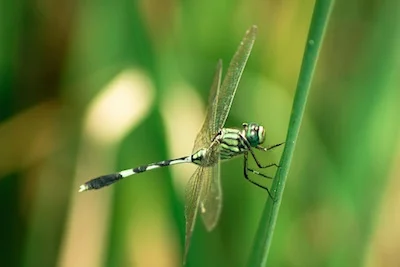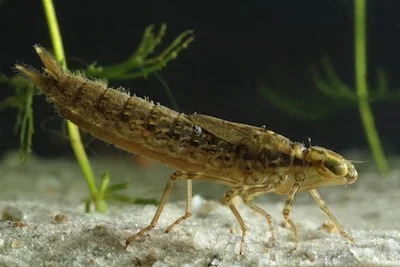A dragonfly is an insect.
A damselfly is an insect that looks like a dragonfly.
They have two wings on each side.
Their wings are clear and help the insects stay in one spot in the air.
Baby dragonflies and damselflies grow up underwater.
Dragonfly ©Getty Images
Dragonflies and their close relatives, damselflies, are insects, but they are not flies.
They have been around on Earth for millions of years, since before the dinosaurs, but then they were much, much bigger than they are today.
They can hover in mid air, and eat other insects by catching them as they fly.
There are three parts to their bodies, head, thorax and long, thin abdomen. They have three pairs of jointed legs and two pairs of transparent wings.
There are thousands of different species (kinds) of dragonflies and damselflies.
Damselfly ©Getty Images
What are the differences between them?
Dragonflies and damselflies are often mistaken for each other because they appear to be quite similar, but there are small differences:
When resting, damselflies hold their wings together above the body, while dragonflies at rest hold their wings flat.
The back wing of the dragonfly is broader near where it joins onto the body.
Damselfly eyes are further apart than those of a dragonfly.
Damselflies are usually smaller than dragonflies.
Dragonflies can fly at 40 kilometres per hour. Damselflies fly more slowly.
The larva is called a nymph ©Getty Images
Life Cycle
Both have three stages in their life cycle: egg, larva and adult.
Female dragonflies and damselflies lay eggs in or near water, often on floating or underwater plants. When laying eggs, some species, or kinds, will go underwater completely in order to lay their eggs on a good surface.
Nymph ready to change into an adult. ©Getty Images
A lava known as a nymph (say nim-ff) hatches out of each of the eggs. Most of the insect's life is spent as a nymph, living beneath the water's surface. Nymphs have internal gills to breathe with and have extendable jaws to catch other invertebrates (creatures without backbone) or even tiny vertebrates (creatures with a backbone) such as tadpoles or fish.
This larval stage of large dragonflies may last as long as five years. In smaller species of dragonfly and damselfly, the nymph stage may last between two months and three years.
As it grows, a nymph sheds its skin because the skin doesn't stretch to allow the larva to grow. This is called moulting (say mole-ting).
When the nymph is ready to change into an adult, it climbs up a reed at night. Exposure to air causes it to start breathing. The skin splits at a weak spot behind the head and the adult insect crawls out of its old larval skin and waits for the sun to rise. Blood flows into the wings and unfolds them. The adult insect flies off to feed on midges and flies. The adult stage of larger species of dragonfly can last as long as four months.
Adult dragonfly emerging from the final moult. ©Getty Images







